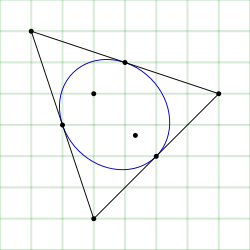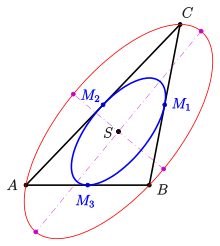Steiner inellipse
In geometry, the Steiner inellipse,[1] midpoint inellipse, or midpoint ellipse of a triangle is the unique ellipse inscribed in the triangle and tangent to the sides at their midpoints. It is an example of an inellipse. By comparison the inscribed circle and Mandart inellipse of a triangle are other inconics that are tangent to the sides, but not at the midpoints unless the triangle is equilateral. The Steiner inellipse is attributed by Dörrie[2] to Jakob Steiner, and a proof of its uniqueness is given by Dan Kalman.[3]

The Steiner inellipse contrasts with the Steiner circumellipse, also called simply the Steiner ellipse, which is the unique ellipse that touches a given triangle at its vertices and whose center is the triangle's centroid.[4]
Definition and properties
- Definition
An ellipse that is tangent to the sides of a triangle at its midpoints is called the Steiner inellipse of triangle .


Properties:
For an arbitrary triangle with midpoints of its sides the following statements are true:
a) There exists exactly one Steiner inellipse.
b) The center of the Steiner inellipse is the centroid of the triangle .
c1) The triangle has the same centroid and the Steiner inellipse of the triangle is the Steiner ellipse of the triangle .
c2) The Steiner inellipse of a triangle is the scaled Steiner Ellipse with scaling factor 1/2 and the centroid as center. Hence both ellipses have the same eccentricity, are similar.
d) The area of the Steiner inellipse is -times the area of the triangle.
e) The Steiner inellipse has the greatest area of all inellipses of the triangle.
[5]:p.146[6]:Corollary 4.2
- Proof
The proofs of properties a),b),c) are based on the following properties of an affine mapping: 1) any triangle can be considered as an affine image of an equilateral triangle. 2) Midpoints of sides are mapped onto midpoints and centroids on centroids. The center of an ellipse is mapped onto the center of its image.
Hence its suffice to prove properties a),b),c) for an equilateral triangle:
a) To any equilateral triangle there exists an incircle. It touches the sides at its midpoints. There is no other (non-degenerate) conic section with the same properties, because a conic section is determined by 5 points/tangents.
b) By a simple calculation.
c) The circumcircle is mapped by a scaling, with factor 1/2 and the centroid as center, onto the incircle. The eccentricity is an invariant.
d) The ratio of areas is invariant to affine transformations. So the ratio can be calculated for the equilateral triangle.
e) See Inellipse.
Parametric representation and semi-axes
Parametric representation:
- Because a Steiner inellipse of a triangle is a scaled Steiner ellipse (factor 1/2, center is centroid) one gets a parametric representation derived from the trigonometric representation of the Steiner ellipse :
- The 4 vertices of the Steiner inellipse are
- where is the solution of
- with
Semi-axes:
- With the abbreviations
- one gets for the semi-axes :
- The linear eccentricity of the Steiner inellipse is
Trilinear equation
The equation of the Steiner inellipse in trilinear coordinates for a triangle with side lengths a, b, c (with these parameters having a different meaning than previously) is[1]
where x is an arbitrary positive constant times the distance of a point from the side of length a, and similarly for b and c with the same multiplicative constant.
Other properties
The lengths of the semi-major and semi-minor axes for a triangle with sides a, b, c are[1]
where
According to Marden's theorem,[3] if the three vertices of the triangle are the complex zeros of a cubic polynomial, then the foci of the Steiner inellipse are the zeros of the derivative of the polynomial.
The major axis of the Steiner inellipse is the line of best orthogonal fit for the vertices.[6]:Corollary 2.4
Denote as G, F+, and F− respectively the centroid and the first and second Fermat points of a triangle. The major axis of the triangle's Steiner inellipse is the inner bisector of ∠F+GF−. The lengths of the axes are |GF−| ± |GF+|: that is, the sum and difference of the distances of the Fermat points from the centroid.[7]:Thm. 1
The axes of the Steiner inellipse of a triangle are tangent to its Kiepert parabola, the unique parabola that is tangent to the sides of the triangle and has the Euler line as its directrix.[7]:Thm. 3
The foci of the Steiner inellipse of a triangle are the intersections of the inellipse's major axis and the circle with center on the minor axis and going through the Fermat points.[7]:Thm. 6
As with any ellipse inscribed in a triangle ABC, letting the foci be P and Q we have[8]
Generalization
The Steiner inellipse of a triangle can be generalized to n-gons: some n-gons have an interior ellipse that is tangent to each side at the side's midpoint. Marden's theorem still applies: the foci of the Steiner inellipse are zeroes of the derivative of the polynomial whose zeroes are the vertices of the n-gon.[9]
References
- Weisstein, E. "Steiner Inellipse" — From MathWorld, A Wolfram Web Resource, http://mathworld.wolfram.com/SteinerInellipse.html.
- H. Dörrie, 100 Great Problems of Elementary Mathematics, Their History and Solution (trans. D. Antin), Dover, New York, 1965, problem 98.
- Kalman, Dan (2008), "An elementary proof of Marden's theorem" (PDF), American Mathematical Monthly, 115 (4): 330–338, JSTOR 27642475, MR 2398412, archived from the original (PDF) on 2012-08-26.
- Weisstein, Eric W. "Steiner Circumellipse". MathWorld.
- Chakerian, G. D. (1979), "A distorted view of geometry", in Honsberger, Ross (ed.), Mathematical plums, The Dolciani Mathematical Expositions, 4, Washington, D.C.: Mathematical Association of America, pp. 135–136, 145–146.
- Minda, D.; Phelps, S. (2008), "Triangles, ellipses, and cubic polynomials" (PDF), American Mathematical Monthly, 115 (8): 679–689, MR 2456092.
- Scimemi, Benedetto, "Simple Relations Regarding the Steiner Inellipse of a Triangle", Forum Geometricorum 10, 2010: 55–77.
- Allaire, Patricia R.; Zhou, Junmin; and Yao, Haishen, "Proving a nineteenth century ellipse identity", Mathematical Gazette 96, March 2012, 161-165.
- Parish, James L., "On the derivative of a vertex polynomial", Forum Geometricorum 6, 2006, pp. 285–288: Proposition 5.